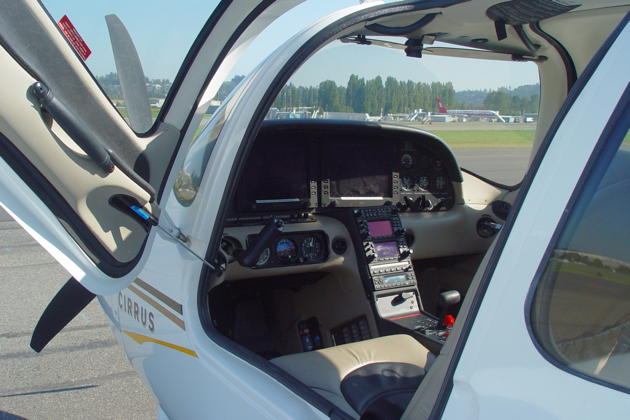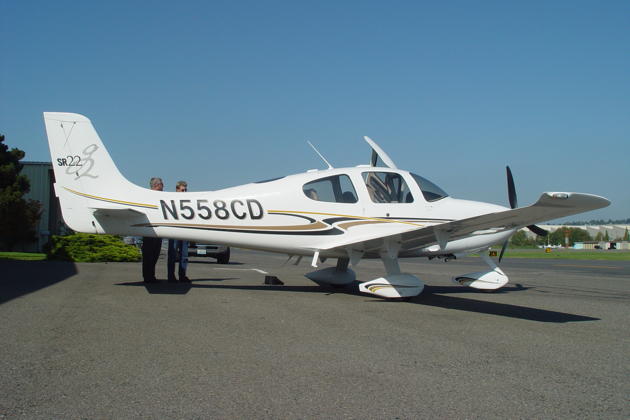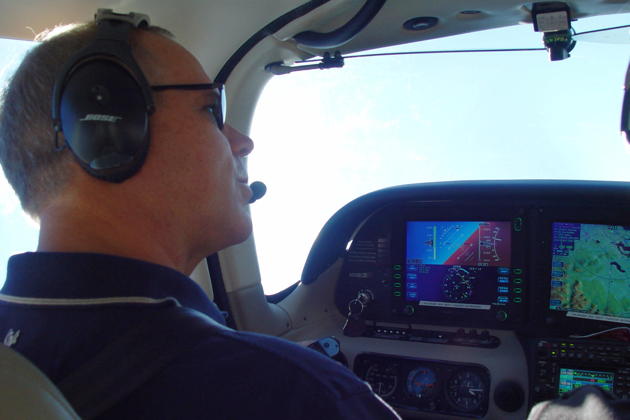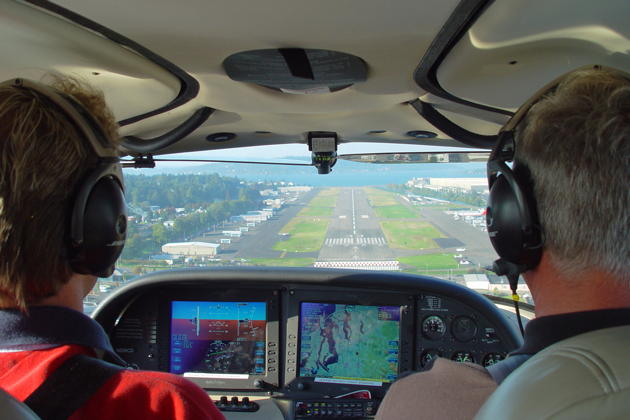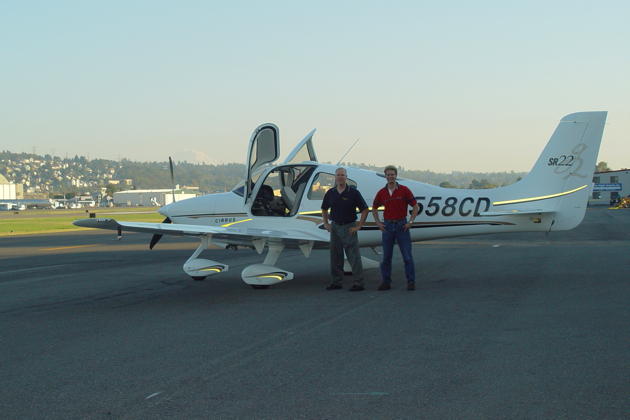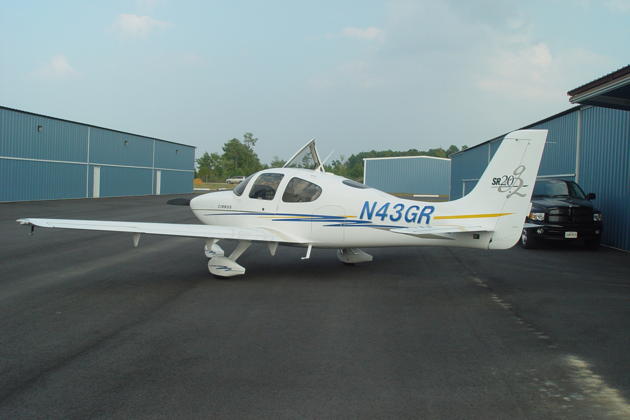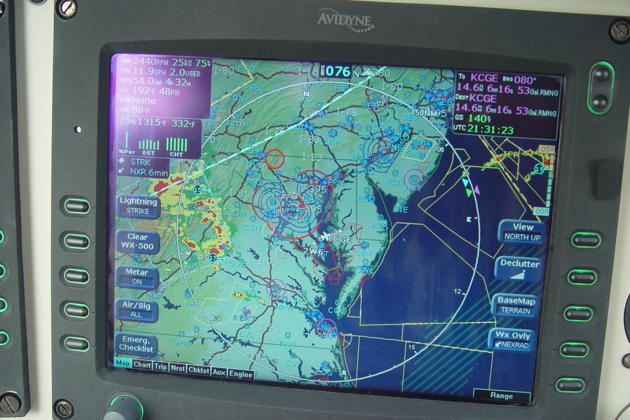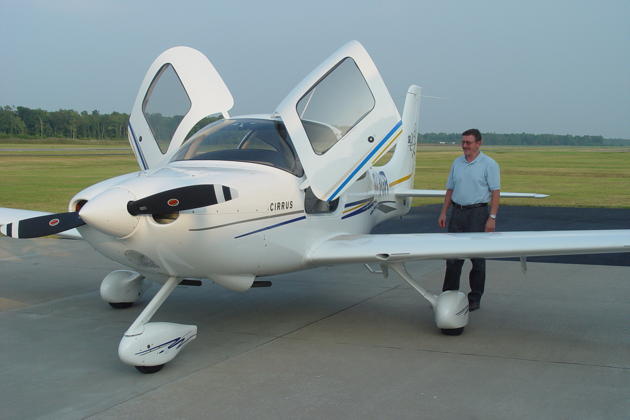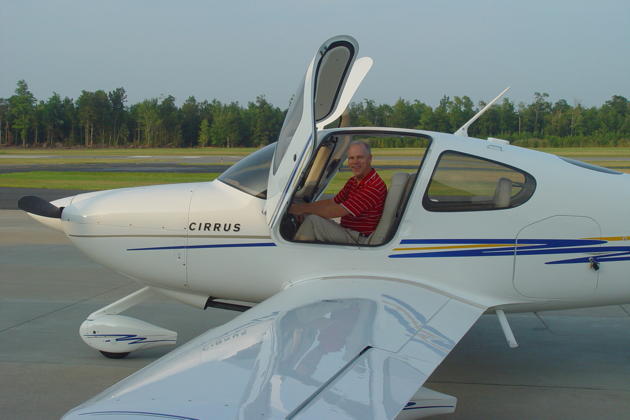FlightLog Archive
∟Aircraft Flown
Flying the Cirrus - Sep 2004
While in Chicago at an American Institute of Aeronautics and Astronautics (AIAA) conference, I attended the awards ceremony that was celebrating contributions of the Cirrus Aircraft Company design team to general aviation aircraft design.
Most of the AIAA attendees didn't appreciate the impressive accomplishments of the Cirrus design team present, so I stopped by their table at the end of the awards luncheon, and congratulated them on their award and on their great Cirrus aircraft. They asked me for a business card, and I expected to get a nice Cirrus brochure in a few weeks.
That evening, while still in Chicago, I got a great e-mail from John Gauch, a Cirrus regional demonstration pilot, saying that he'd have both an SR-20 and an SR-22 in Portland the following week, and to let me know which one I would like him to bring to the Seattle area for me to fly! You gotta love these guys. I asked John to bring an SR-22, their top end machine, to Renton airport the following Monday.
Right on his scheduled time of 2:00 on a beautiful, sunny Monday afternoon, John arrived at the base of Renton tower with a brand new SR-22G2 demo aircraft, N558CD. I had also invited my partner in my Warrior, Mark LaVille, along for a taste of the Cirrus. John Gauch took us through a thorough external pre-flight, and Mark jumped in back while I took the left seat as pilot-in-command.
The fit and finish of the Cirrus, both inside and out, is phenomenal. The interior cockpit is dominated by two huge 8x10 inch Avidyne Entegra flat panel LCD displays, which were noticeable not only for their size, but their brightness and sunlight readability. We strapped in, and John described the basic cockpit switchology, and I cranked the engine quickly, since most of the needed information is contained on the beautiful 8x10s.
John and I reviewed the displayed checklists, and I taxied for a run-up check. Steering was easy, and the checklist procedures walked me through the run-up items. I was already getting used to the feel of the left hand side stick, which is actually referenced as a side yoke.
I was cleared for takeoff on Runway 33 at Renton, and we leaped off the runway powered by the SR-22G2's 310 HP Continental engine, and established a 1000+ FPM climb rate into a working area near the Cascade foothills. The SR-22 was equipped with a SKYWATCH system, which started providing aural alerts of traffic, including range and clock position, allowing us to easily pick up traffic as we exited out of Renton's local airspace.
I flew a number of medium and steep-bank turns, while getting a better feel for the side stick. As in any aircraft, using trim was helpful in maintaining good pitch control. The situational awareness provided by the large 8x10 displays, the aural traffic warnings, and the good visibility from the cockpit blended together well. The performance and speed of the SR-22G2 were also outstanding, especially considering the fixed landing gear. As I returned to the Renton airport area, I was initially looking for a gear handle, since our cruise speed was so high that it didn't seem like a fixed gear design.
The biggest problem I had on approach was slowing the Cirrus down! It's a very clean, slick airplane, so I tried a slip on final, which felt very comfortable as a way to establish a normal glidepath.
Mark LaVille now got his opportunity to fly, and I jumped in the back seat for his flight, which was again a blast. Mark had no problem with the side stick, and learned from my experience and had an easier time slowing on final.
In too short a time the demo flights were over, and John Gauch provided us with a bunch of Cirrus literature, some of which I provided to the Boeing Employees Flying Association (BEFA) leadership. BEFA has since acquired an SR-20.
Thank you, Cirrus, and thanks, John for a great opportunity to fly your outstanding airplane!
Part 2 - Flying the Cirrus SR-20 - August 2006
I was traveling to Pax River, MD for business, and made contact with Gil Rud from our local office there. Gil was the Blue Angels commander from 1986-1988, as they transitioned from A-4s to F/A-18s. Although retired from the Navy, Gil was keeping his hand in aviation while flying his own Cirrus SR-20, which he based at nearby St. Mary's County airport in Leonardtown, MD (2W6).
Since Gil said to touch base when I was in town to check out his Cirrus, I took him up on his offer. I met Gil in his office in the afternoon, and we made the short drive to St. Mary's County airport. Since a weather system was heading in from the west, we decided to make a short trip to enjoy the Cirrus and also try some local seafood.
We launched quickly and headed east across the Patuxent River, and then over the Chesapeake Bay to the eastern portion of Maryland. The combination of the Cirrus speed and direct travel, via air, turned a 2 hour and 45-minute car trip to a 25-minute flight to the Cambridge-Dorchester airport, MD (KCGE). I again marveled at the smoothness of the Cirrus handling, trying the right side stick this time, which actually felt more 'normal', given my previous center and right stick experience.
As we let down into the Cambridge-Dorchester airport, we checked on the progress of the storms to the west, and planned our departure to give us adequate time on our return. Gil wanted to introduce me to the excellent crab cakes at Kay's at the Airport, which is now named Katie's, for her daughter. We enjoyed our meal and aircraft banter, then took off and smoked west back to St. Mary's County, landing ahead of the storms. Gil demonstrated the Cirrus autopilot as we descended in, which allowed us to scan for traffic as we let down in hazy conditions. Thanks, Gil - I can have my arm twisted into flying a Cirrus any day!
Epilog
GIl had been doing a lot of flying in his SR-20, but was contemplating an upgrade. He now owns an SR-22 (N330SR), and since his retirement from Boeing, uses it as he commutes between his Maryland and San Diego residences.
 KASPRZYK
KASPRZYK